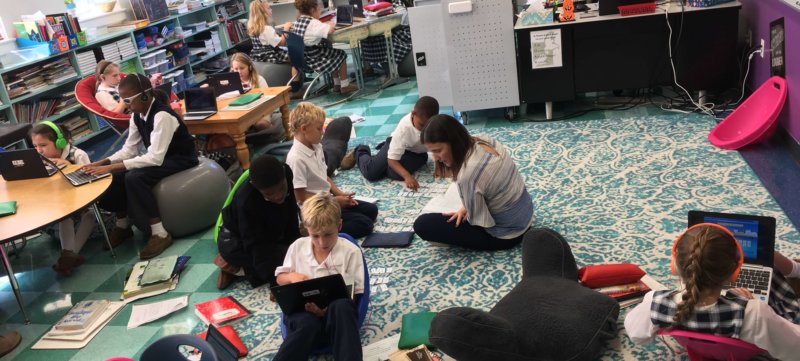Mrs. Kara Sherman, a fourth grade teacher at St. Francis of Assisi School in Baltimore, helps students reach their full potential by implementing flexible seating in her classroom. Mrs. Sherman, who was hired as a new teacher to St. Francis this year, immediately immersed herself into getting up to speed and has proved a strong and positive presence in the classroom and the school. Her predecessor had begun to develop a flexible seating model, and when given the choice to continue that inherited path or return her new classroom to a more traditional model, she chose to embrace flexible seating. She spent weeks in the late summer researching and learning about flexible seating, and then quickly sought out inexpensive ways to make this model work at a small Catholic school. The results have been tremendous! Her students are actively engaged in the learning process, and use their freedom to choose comfortable seating responsibly and maturely. Mrs. Sherman built student capacity for this new model in the first few weeks of school through careful practice and discussion with students about expectations. Now the dynamic has become routine and the students are thriving!
When asked to describe the best part of the flexible seating experience so far, Mrs. Sherman said “My room feels like a living room instead of a classroom. It’s comfortable and welcoming. It is not my classroom, it is OUR classroom. Giving them the choice to sit where and how they see fit changes the dynamics of the class. Every day the first thing they do is make a choice to be active learners and they are held accountable for their own education. It seems crazy to think such a little thing like letting them choose where they sit could impact everything else, but it does. They have a say in how they learn. I’m not dictating to them how it has to be. I’m not forcing them to fit the mold of how a traditional student should look. My favorite thing to do is stand back when they are completely engaged in learning and simply observe them…observe how no two students learning looks the same, some children are bouncing or rocking, some are standing or kneeling on the hard floor while others are kneeling or sitting on cushions, all the while they are all doing their best learning. ”

